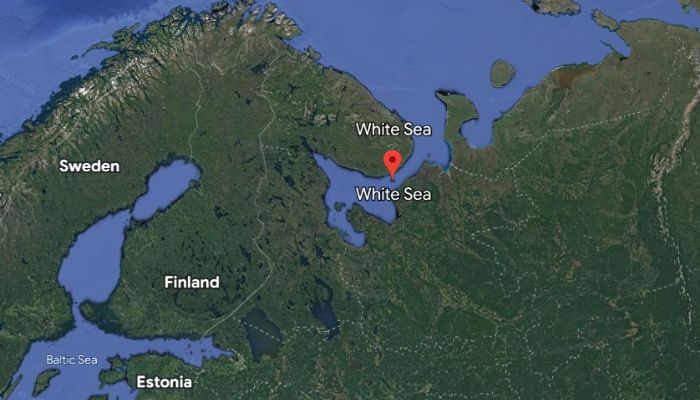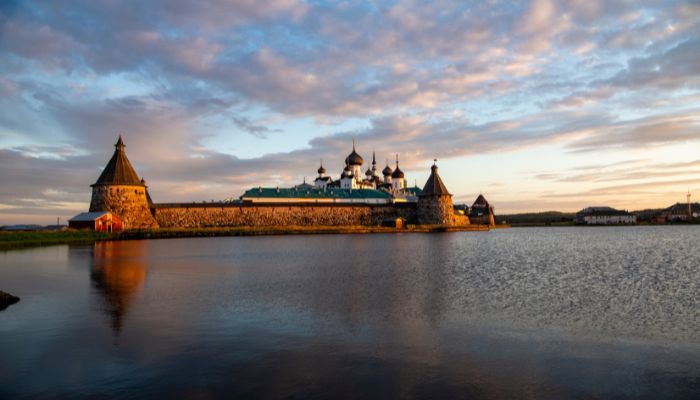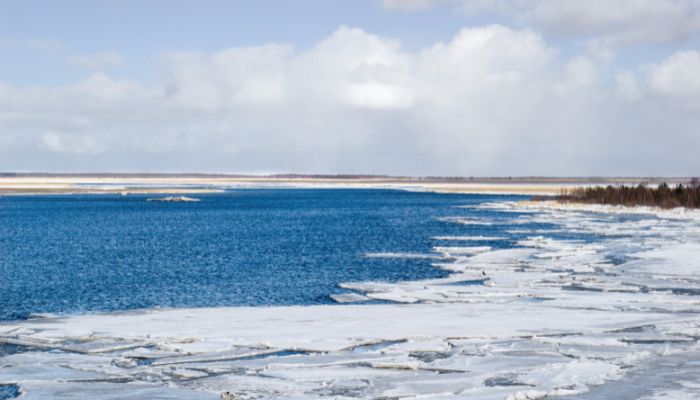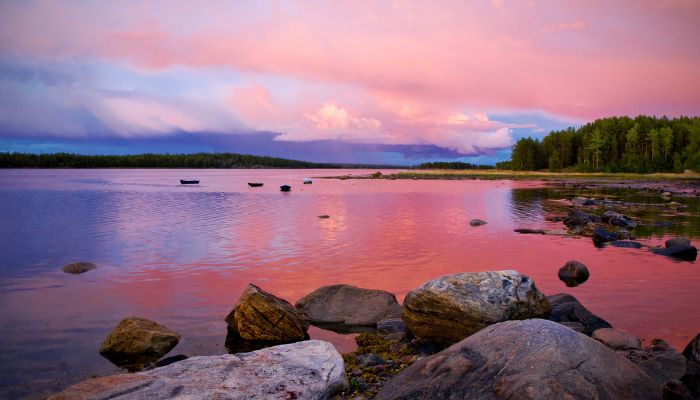10 White Sea Facts You Might Not Know
The White Sea is a magnificent body of water lying on Russia’s northwestern shores. It is the smallest sea in the Russian Federation and is the southern arm or inlet of the Barents Sea. It is called Beloye More in Russian and is almost landlocked. It is administered by the oblasts of Arkhangelsk and Murmansk, including the Republic of Karelia.
From the west, it is surrounded by Karelia, while the Kola Peninsula encloses it from the north and Kanin Peninsula from the northeast.
It is one of the 4 seas in the world, which is named after common colours, the other 3 being the Black Sea, the Red Sea and the Yellow Sea. However, it is probably named the ‘White Sea’ since it is covered with ice for most of the year.
The White Sea covers around 36,680 square miles or 90,0000 square kilometres. The waters are about 200 ft or 60 m deep, while the maximum depth is 1,115 ft or 340 m. The deepest point can be found in the northeastern region of the Kandalaksha inlet.
Let us have a look at 10 interesting White Sea Facts you might not know about.
1. Gorlo Strait connects the White Sea with the Barents Sea, while the White Sea Canal links it to the Baltic Sea
The Gorlo Strait is a relatively smaller and shallower basin having a maximum width of 45 to 50 kilometres and a 100 m depth. It links the inner regions of the White Sea with the outer ones and, via those, connects the White Sea to the Barents Sea.
Gorlo Strait is characterised by frontal zones which separate its waters in the north and south. It also has strong, quickly changing tidal currents and sand and coarse deposits.

The White-Sea Baltic Canal, also called the White Sea Canal, is an important maritime waterway in Russia which became operational in 1933. It links the White Sea with Lake Onega, which is then linked to the Baltic Sea.
The canal’s total length is 227 km or 141 miles, and it runs along many rivers and Vygozero lake. It is historic since it was one of the first major construction projects undertaken by the Soviet Union.
The strategic waterway shortens the voyage from St. Petersburg to Arkhangelsk by 4000 kilometres. The main cargo carried through the canal consists of timber for the local paper mills.
2. White Sea has 4 major Bays or Gulfs.
The White Sea has an irregular shape which is created by the four large gulfs or bays, namely the Kandalaksha Gulf, Dvina Gulf, Onega and Mezen Gulf.
The Kandalaksha Gulf lies at the northwestern corner of the White Sea. The Kandalaksha city is situated at its northern end, while the Vitino oil port is situated ten kilometres towards the south.
It is quite shallow and goes 300 m deep towards the west. Its upper reaches were categorised as Ramsar Wetland in 1976. They serve as breeding areas for sea ducks and other migratory birds.
Onega is the southernmost bay out of all the four bays in the White Sea. It covers 6630 sq km and measures 185 km lengthwise and 100 km breadthwise. Its average depth is 16 m. Rivers like Onega, Vyg and Kem flow into it.
Another significant bay is Dvina which is fed by the Northern Dvina River. The cities Arkhangelsk and Severdodvinsk lie on Dvina Bay. It is approximately 93 km long and 130 km wide.
Many villages at the bay’s coast, like Lopshenga, are old pomor settlements largely dependent on fishery even today.
The easternmost bay is Mezen since it is located to the south of the Kanin Peninsula. Kuloy and Mezen Rivers flow into the bay, while Morzhovets Island lies at its entrance. It spans 2560 square miles, is 105 km long, and is 97 km broad.
3. Solovetsky Islands lie in the centre of the White Sea
Several islands lie in the White Sea. However, the Solovetsky archipelago comprising six islands, is quite famous. They cover approximately 347 sq km and are formed of granite and gneiss. The islands separate the Bay of Onega from the White Sea.
The islands have hilly terrain and are filled with Pine trees and Spruce forests, part of which create swamps. Lakes on these islands were connected to form a canal network.

An attractive feature of these islands is the stone labyrinths such as those of the Bolshoi Zayatsky island. Though found in many places over North Europe, most have not been preserved in their original form. However, the ones on these islands are some of the best remaining ones.
They are also known for being the site of the popular Solovestsky Monastery and also became the site of the 1st Gulag or Soviet Prison Camp.
The biggest island in Kandalaksha Gulf is Velikiy. Situated near the shore, it is known for its beautiful seashore and wildlife.
4. Home to over 700 species of invertebrates
The White Sea hosts over 60 fish species, such as Atlantic cod, Saffron cod, European Smelt, Herring, Atlantic Salmon etc.
Many marine animals live in this sea, such as the Beluga Whale. It is a small white whale capable of mimicking human speech. Many whales visit the sea, such as orcas, humpbacks, bowhead whales, northern bottlenose whales, etc. Harp seals and ringed seals can also be seen swimming in the waters of the White Sea.
The fishing industry is not very profitable and is quite small due to the difficulty in navigation. Also, the sea is covered with thick ice most times of the year.
The White Sea has a comparatively lower biodiversity of plant species; however, many kinds of algae, mosses and lichens are found in the region. The most famous plants include the Arctic willow, which is a small shrub, and secondly, a type of brown algae that thrives in intertidal zones. Cladonia is a lichen that grows on rocks and is a food source for reindeer.
5. A growing seaweed industry is taking shape in the White Sea region.
To promote sustainable development and economic growth, seaweed farming has been gaining popularity in the White Sea. Seaweed species suitable for farming here include wakame, kelp, dulse and nori. Known for their high nutrient content, they have varied applications in the food industry, pharmaceuticals, and cosmetics.
This also comes with a lot of advantages, such as reducing overfishing and promoting sustainable seafood production in the region. Secondly, seaweed absorbs CO2 from the atmosphere and helps tackle climate change. It can also provide economic benefits to coastal communities.

Nonetheless, seaweed farming in the White Sea has many challenges, such as cold waters and low sunlight that could hamper the growth of some species. Additionally, the harsh climate and the unfavourable location could make it cumbersome to transport and market the seaweed and its products.
Given all these issues, seaweed farming in this region has much potential to become a profitable business in the years to come. Ongoing research is exploring new techniques of cultivation and selection of species.
6. Seven major ports lie in the White Sea.
About 7 major ports are situated along the White Sea, including Belomorsk, Mezen, Umba, Kem, Arkhangelsk, Onega and Kandalaksha. Navigation continues in the sea throughout the year, especially in winter, with the aid of icebreaker ships.
Arkhangelsk is the biggest port on the White Sea and one of the most crucial ports in Russia. Situated on the right bank of the Northern Dvina River, it has a long history and has served as an important trade and transportation centre since the 16th century. Today, it handles a variety of cargo, including oil, coal, timber and minerals.
It is also a container shipping hub and has ferry connections to nearby cities like Mezen and Solovetsky.
Onega is another facility on the western coast of the White Sea. It lies at the mouth of river Onega and is an important centre for the fishing and timber industry.
The port of Severodvinsk handles timber, oil and industrial products. It is a hub for seafood processing, fishing, shipbuilding and other heavy industry. The modern facility has many container terminals and expansive storage facilities.
Since the city has numerous naval bases and shipyards, it is also used for constructing and maintaining submarines and military vessels. Apart from these ports, there are other smaller ones found throughout the region.
7. Experiences a Subarctic climate
The White Sea lies in the Arctic region of Russia and experiences a polar and moderate continental climate characterised by the frequent occurrence of thick fog and cloudy days. The winters are long and extremely cold, while summers are quite short.
During winter, the White Sea is covered by ice, and the temperature can drop to -30°C in January and February. Spring begins by April end or the beginning of May when Ice begins to melt.

In summer, the surface water temperature is about 15-18°C in the central part of the sea, while it remains cold, about 7-8 degrees celsius in the northern part. The sky is cloudy, and there are frequent downpours.
On the whole, the White Sea has a harsh climate with very limited opportunities for human growth and economic development. However, it is a pristine marine ecosystem that has largely remained untouched by human activity.
8. One of the oldest settlements along the White Sea is Kholmogory
The inhabitants of Novgorod, one of the oldest Russian cities, were aware of the White Sea from the 11th century. They began navigating in its waters and explored the forests on its coast, which were a source of fur animals.
The earliest settlement close to the shores took shape in the 14th century in Northern Dvina. Kholmogory received its first foreign vessel in 1553. It was the English vessel, Edward Bonaventure, led or commanded by Richard Chancellor.
After the English, Dutch ships came, and Kholmogory port became a busy facility handling fur and fish. Many shops and factories came up, and a fortress was also built.
Hence, from the 15th-18th centuries, the White Sea functioned as a principal maritime route for Russia. However, its significance reduced after St Petersburg was founded. It led to the creation of a direct and ice-free link between Russia and regions in Western Europe through the Baltic Sea.
After the Murmansk port was opened in 1916, most Russian shipments were handled here since it was navigable even in winter.
9. Said to have formed in the last glacial period
According to researchers, the formation of the White Sea was a complicated process that occurred over millions of years. It was possibly created during the last glacial period that ended around 12,000 years ago.
In this period, the sea level was quite low compared to what it is today. In that period, the region that is the White Sea was a river valley. As the climate became warmer and the glaciers melted, the sea levels increased, and the valley was flooded with water, ultimately forming the White Sea.

After that, it underwent many geological changes. The bottom of the White Sea has a broken relief with several ridges, depressions and valleys, a result of tectonic movements, erosion and sedimentation. The sea bed is lined with a layer of sediment.
10. Has low levels of salinity compared to other seas of the world
The White Sea has lower salinity levels, with an average salinity of about 23-25 parts per thousand. This is because of the inflow of freshwater from the major rivers that empty into the sea as well as its geographic location in the Subarctic, which experiences less evaporation and higher precipitation.
Salinity varies due to other factors such as seasonal changes, oceanographic conditions and weather patterns. For instance, salinity increases in winter as the surface freezes and freshwater is removed from the surface. Similarly, in summers, the ice melts and increased river runoffs lead to a decrease in salinity.
The lower salinity levels of the White Sea make it a unique aquatic ecosystem with a diverse range of plant and animal species, some of which are not found anywhere else in the world.
You might also like to read-
- 10 Mozambique Channel Facts You Might Not Know
- 10 Southern Ocean Facts You Might Not Know
- 12 Interesting Facts About The Pacific Ocean
- 12 Siberian Sea Facts You Must Know
- 12 Interesting Facts About The Pacific Ocean
Disclaimer :
The information contained in this website is for general information purposes only. While we endeavour to keep the information up to date and correct, we make no representations or warranties of any kind, express or implied, about the completeness, accuracy, reliability, suitability or availability with respect to the website or the information, products, services, or related graphics contained on the website for any purpose. Any reliance you place on such information is therefore strictly at your own risk.
In no event will we be liable for any loss or damage including without limitation, indirect or consequential loss or damage, or any loss or damage whatsoever arising from loss of data or profits arising out of, or in connection with, the use of this website.
Do you have info to share with us ? Suggest a correction
Disclaimer :
The information contained in this website is for general information purposes only. While we endeavour to keep the information up to date and correct, we make no representations or warranties of any kind, express or implied, about the completeness, accuracy, reliability, suitability or availability with respect to the website or the information, products, services, or related graphics contained on the website for any purpose. Any reliance you place on such information is therefore strictly at your own risk.
In no event will we be liable for any loss or damage including without limitation, indirect or consequential loss or damage, or any loss or damage whatsoever arising from loss of data or profits arising out of, or in connection with, the use of this website.

About Author
Zahra is an alumna of Miranda House, University of Delhi. She is an avid writer, possessing immaculate research and editing skills. Author of several academic papers, she has also worked as a freelance writer, producing many technical, creative and marketing pieces. A true aesthete at heart, she loves books a little more than anything else.
Latest Maritime Knowledge Articles You Would Like:
Subscribe To Our Newsletters
By subscribing, you agree to our Privacy Policy and may receive occasional deal communications; you can unsubscribe anytime.















